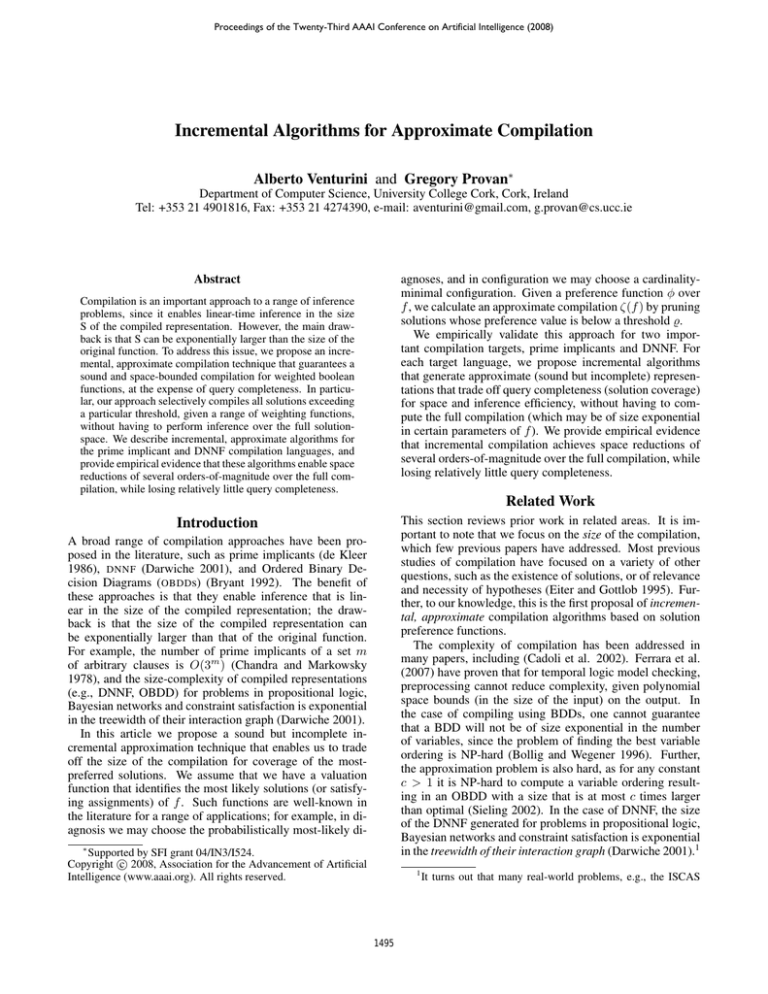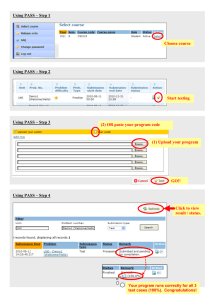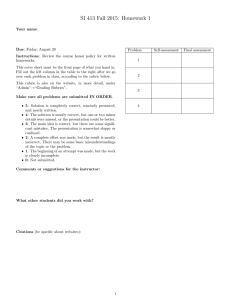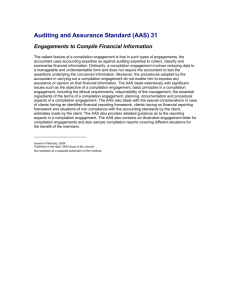
Proceedings of the Twenty-Third AAAI Conference on Artificial Intelligence (2008)
Incremental Algorithms for Approximate Compilation
Alberto Venturini and Gregory Provan∗
Department of Computer Science, University College Cork, Cork, Ireland
Tel: +353 21 4901816, Fax: +353 21 4274390, e-mail: aventurini@gmail.com, g.provan@cs.ucc.ie
Abstract
agnoses, and in configuration we may choose a cardinalityminimal configuration. Given a preference function φ over
f , we calculate an approximate compilation ζ(f ) by pruning
solutions whose preference value is below a threshold %.
We empirically validate this approach for two important compilation targets, prime implicants and DNNF. For
each target language, we propose incremental algorithms
that generate approximate (sound but incomplete) representations that trade off query completeness (solution coverage)
for space and inference efficiency, without having to compute the full compilation (which may be of size exponential
in certain parameters of f ). We provide empirical evidence
that incremental compilation achieves space reductions of
several orders-of-magnitude over the full compilation, while
losing relatively little query completeness.
Compilation is an important approach to a range of inference
problems, since it enables linear-time inference in the size
S of the compiled representation. However, the main drawback is that S can be exponentially larger than the size of the
original function. To address this issue, we propose an incremental, approximate compilation technique that guarantees a
sound and space-bounded compilation for weighted boolean
functions, at the expense of query completeness. In particular, our approach selectively compiles all solutions exceeding
a particular threshold, given a range of weighting functions,
without having to perform inference over the full solutionspace. We describe incremental, approximate algorithms for
the prime implicant and DNNF compilation languages, and
provide empirical evidence that these algorithms enable space
reductions of several orders-of-magnitude over the full compilation, while losing relatively little query completeness.
Related Work
This section reviews prior work in related areas. It is important to note that we focus on the size of the compilation,
which few previous papers have addressed. Most previous
studies of compilation have focused on a variety of other
questions, such as the existence of solutions, or of relevance
and necessity of hypotheses (Eiter and Gottlob 1995). Further, to our knowledge, this is the first proposal of incremental, approximate compilation algorithms based on solution
preference functions.
The complexity of compilation has been addressed in
many papers, including (Cadoli et al. 2002). Ferrara et al.
(2007) have proven that for temporal logic model checking,
preprocessing cannot reduce complexity, given polynomial
space bounds (in the size of the input) on the output. In
the case of compiling using BDDs, one cannot guarantee
that a BDD will not be of size exponential in the number
of variables, since the problem of finding the best variable
ordering is NP-hard (Bollig and Wegener 1996). Further,
the approximation problem is also hard, as for any constant
c > 1 it is NP-hard to compute a variable ordering resulting in an OBDD with a size that is at most c times larger
than optimal (Sieling 2002). In the case of DNNF, the size
of the DNNF generated for problems in propositional logic,
Bayesian networks and constraint satisfaction is exponential
in the treewidth of their interaction graph (Darwiche 2001).1
Introduction
A broad range of compilation approaches have been proposed in the literature, such as prime implicants (de Kleer
1986), DNNF (Darwiche 2001), and Ordered Binary Decision Diagrams (OBDDs) (Bryant 1992). The benefit of
these approaches is that they enable inference that is linear in the size of the compiled representation; the drawback is that the size of the compiled representation can
be exponentially larger than that of the original function.
For example, the number of prime implicants of a set m
of arbitrary clauses is O(3m ) (Chandra and Markowsky
1978), and the size-complexity of compiled representations
(e.g., DNNF, OBDD) for problems in propositional logic,
Bayesian networks and constraint satisfaction is exponential
in the treewidth of their interaction graph (Darwiche 2001).
In this article we propose a sound but incomplete incremental approximation technique that enables us to trade
off the size of the compilation for coverage of the mostpreferred solutions. We assume that we have a valuation
function that identifies the most likely solutions (or satisfying assignments) of f . Such functions are well-known in
the literature for a range of applications; for example, in diagnosis we may choose the probabilistically most-likely di∗
Supported by SFI grant 04/IN3/I524.
c 2008, Association for the Advancement of Artificial
Copyright Intelligence (www.aaai.org). All rights reserved.
1
1495
It turns out that many real-world problems, e.g., the ISCAS
Notation and Preliminaries
It is clear from the definition that a compilation ζ(f ) preserves the models of f . In order to find the value Q(f, σ),
we process the fixed part f off-line, thus obtaining ζ(f ),
and then we find the value Q0P (ζ(f ), σ). Compilation is
worthwhile if answering the query Q0P (ζ(f ), σ) is easier
than answering Q(f, σ). Note that we do not restrict the
time needed to compute the function ζ.
This definition of compilation captures all of the compilation approaches that have been proposed in the literature, such as PIs (de Kleer 1986), DNNF (Darwiche 2001),
and OBDDs (Bryant 1992). These approaches all make
space/time tradeoffs, i.e., they typically generate compilations from which a variety of classes of inference can be
done in time linear in the size of the compiled representation,
although the compilation may require significant space.
Propositional Logic
We assume a standard propositional logic in this paper.
We use a finite alphabet of propositional symbols, Σ =
{z1 , z2 , ..., zn }, using the usual boolean connectives ∧, ∨, ¬,
and ⇒ for constructing well-formed formulae from Σ. A
literal is a propositional symbol or its negation. A clause
z1 ∨ z2 ∨ · · · ∨ zk ∨ ¬zk+1 ∨ · · · ∨ ¬zn is a disjunction of
literals. A clause is Horn (definite Horn) if k ≤ 1 (k = 1).
A function (or formula) f is a conjunction of clauses; in this
article we assume that a formula is defined over n symbols,
unless stated otherwise. The size of a formula f is |f |.
A (partial) interpretation γ for Σ, a mapping from (a subset of ) Σ to {true, false}, can be extended to boolean formulae in the usual recursive way. Γ is the set of all interpretations. A partial solution is a partial interpretation consistent with f . A model of a formula f is an interpretation γ
that maps f to true. B is the set of all boolean formulae over
Σ. The function atoms : B → 2Σ maps a formula f to the
set of propositional symbols occurring in f .
Preference-Based Compilation
This section introduces the notion of a preference function
φ over f , and of compiling f with respect to φ.
Assume that we have a full compilation ζ(f ) such that we
can specify the space of solutions, Λ. We can rank-order the
solutions of Λ according to a given preference function φ
into a set of equivalence classes, in which each equivalence
class is characterised by the same φ value.
We now consider the case where we use a preference
function φ to guide the choice of compilation target, i.e.,
we aim to compile the most-preferred solutions.
Prime implicants An implicant I of a formula f is a conjunction of literals such that I ⇒ f . An implicant I is a
prime implicant (PI) if, for every conjunct J obtained by removing one or more literals from I, J 6⇒ f . In other words,
a prime implicant is a minimal implicant of f . The disjunction ∆ of all prime implicants of a formula f is equivalent
to f , i.e. ∆ preserves the models of f . The size of ∆ is the
sum of the size of all prime implicants.
Definition 2 (Preference Function). A preference function φ
defined over the solutions Λ of f defines a partial ordering over Λ. We say that solution λ1 ∈ Λ is preferred to solution
λ2 ∈ Λ, written λ1 λ2 , if φ(λ1 ) > φ(λ2 ).
Decomposable Negation Normal Form A formula f is in
Negation Normal Form (NNF) if its literals are joined using
only the operators ∨ and ∧. The Decomposable Negation
Normal Form (DNNF) is a subclass of NNF satisfying the
decomposability property, i.e., for every conjunction α =
α1 ∧ α2 ∧ . . . ∧ αn in a DNNF, it holds that atoms(αi ) ∩
atoms(αj ) = ∅ for i 6= j. A DNNF can be represented
by a rooted directed acyclic graph, where each leaf node is
associated with a literal or truth value, and each intermediate
node corresponds to either ∨ or ∧. Given this representation,
the size of a DNNF is the number of edges in the graph.
We now restrict ourselves to the domain of propositional
abduction. A propositional abduction problem (PAP) can be
defined using a triple hH, µ, f i where H and µ are sets of
variables, while f is a propositional formula. H is typically
referred to as the hypotheses, and µ as the manifestations.
Some important preference-criteria that are widely used in
the literature for PAP compilation include Subset-inclusion
(φ⊆ ), Cardinality (ϑ) and Probability (P r).
One key criterion is that the compilation preserves preference functions, which is guaranteed for the standard compilation languages, which preserve the models of f .
Compilability
We address abduction problems whose instances can be expressed as the pair hf, σi, where f is the fixed part (instanceindependent) and σ is the varying part (instance-dependent).
Given a problem P , an instance hf, σi of P with f ∈ B and
σ ∈ Σ∗ and a query function QP : B × Σ∗ → {yes, no}, we
are interested in finding the value QP (f, σ).
Definition 3 (Preference Preservation). A compilation ζ(f )
preserves a preference function φ if, given hf, σi, for any
pair of solutions λ1 , λ2 such that λ1 , λ2 ∈ Λf and λ1 , λ2 ∈
Λζ(f ) , λ1 λ2 is valid in ζ(f ) iff λ1 λ2 is valid in f .
Since we are interested in compiling only the mostpreferred solutions, we define preferred approximate compilations as compilations including only a subset of mostpreferred solutions:
Definition 1 (Compilation). Given a problem P , an instance
hf, σi of P and a query function QP , we define a compilation function of f , ζ(f ), such that there exists a query function Q0P : ζ(B) × Σ∗ → {yes, no} and ∀hf, σi ∈ B × Σ∗ it
holds that Q0P (ζ(f ), σ) = QP (f, σ).2
Definition 4 (Preferred Approximate Compilation). Given
a compilation ζ(f ) with space of solutions Λζ(f ) , ζ(f )
denotes a preferred approximate compilation of f if: (1)
benchmark circuits (Brglez, Bryan, and Kozminski 1989), do not
have treewidths bounded by some relatively small integer, in order
to ensure compact DNNF compilations.
2
Note that this definition differs from the original definition of
(Cadoli et al. 2002), where a compilation is assumed to be of size
polynomial in |f | and answering the query Q0P is assumed to require a time polynomial in |σ| + |ζ(f )|.
1496
Λζ(f ) ⊆ Λf ; and (2) ∀λ1 ∈ Λζ(f ) , ∀λ2 ∈ Λf \ Λζ(f ) , it
holds that λ1 λ2 .
To focus on the most-preferred solutions, we assign a valuation threshold %. We aim to compile all solutions with
valuations at least as preferred as %, denoted Λ% ; solutions
with valuations less-preferred than % are denoted Λ%̄ .
Definition 5 (%-sound compilation). Given a preference
function φ over f and a threshold %, the preferred approximate compilation ζ(f ) denotes a %-sound compilation of
f if: (1) ζ(f ) preserves the preference function φ; and (2)
ζ(f ) contains every solution λ ∈ Λ% , i.e. Λζ(f ) ⊇ Λ% .
We have designed our algorithms to incrementally generate partial solutions of increasing size only if the partial solution at each step is more preferred than %. We call this approach partial-solution extension (PSE), which we can prove
holds for the set φ∗ of preference functions φ⊆ , ϑ, P r.
Theorem 1. Given a preference function φ ∈ φ∗ over f and
a threshold %, partial-solution extension (PSE) is guaranteed to generate a %-sound compilation of f .
We have developed PSE algorithms for PI and DNNF
compilations; we omit full pseudocode descriptions and
proofs of the correctness of these algorithms due to space
limitations, but note that they are special cases of the above
theorem. Our notion of preference-based compilation is
different to the use of cost functions for DNNF minimaldiagnosis extraction (Darwiche 1998). The cost-function approach aims to compute the most-preferred diagnosis given
a complete DNNF and an observation; in our case we are
incrementally compiling all solutions which are more preferred than a given threshold %. Hence, whereas using probabilistic cost-functions can prune a complete DNNF such that
valid solutions may be lost (Darwiche 1998), the thresholdbased incremental compilation guarantees that no solutions
λ ∈ Λ% will fail to be included in the approximate compilation, as shown in Theorem 1.
60000
R = [0, 1]
R = [0.8, 1]
R = [0.95, 1]
R = [0.99, 1]
50000
Prime implicants
40000
30000
20000
10000
0
1e-20
1e-18
1e-16
1e-14
1e-12
1e-10
1e-08
1e-06 0.0001
0.01
1
Threshold
Figure 1: Number of prime impicants of a formula f encoding a
16-gate circuit; each graph refers to a different probability range.
In order to calculate approximate compilations, we modify the second step of the original algorithm so that instantiations less preferred than the threshold % are not considered.
Thus, we take into account only those DNNF representations
that encode partial solutions more preferred than %.
Empirical Results
We have implemented the above algorithms and carried out
experiments that compare the PI and DNNF approaches,
measuring the size and coverage trade-off of compilations.
All our experiments were run with a set of formulae representing a suite of digital circuits. The digital circuits were
generated randomly by a circuit generator program (Provan
and Wang 2007), such that the circuits have properties similar to those of the ISCAS circuit benchmarks (Brglez, Bryan,
and Kozminski 1989). Each circuit is represented by a formula f defined over a set of boolean variables V = H ∪ K,
where a variable hi ∈ H denotes the health of gate i, and
variables in K denote input/output signals. To each variable
hi ∈ H, i = 1, ..., m we assign a probability valuation by
randomly sampling the value for P r(hi = 1) = p from a
uniform distribution overQ
ranges R = [i, 1], with 0 ≤ i < 1.
m
We compute P r(H) = i=1 P r(hi ) by assuming that all
components fail independently.
Figure 1 shows how the number of solutions varies with
different thresholds and weight ranges. Depending on the
range R we obtain distributions that decrease more or less
gradually to 0. The number of preferred PIs decreases as
i → 1 for all threshold values % > 0. We can control
the number of solutions (and thus the size and coverage of
the approximate compilation) by selecting appropriate (i, %)
combinations. In the following experiments we used a range
R = [0.99, 1]; however, our experimental data indicate that
we obtain similar results using different ranges.
Figure 2 compares the size of a full PI compilation with
full and approximate DNNF compilations. The size of compilations grows exponentially in the size of the input; however, a full DNNF compilation is more succint than a full
PI compilation, achieving in some cases a memory saving
of 50%. Moreover, approximate compilations can save a
Incremental Compilation Algorithms
Prime Implicants Our PI algorithm is based on the
PRIME algorithm (Shiny and Pujari 2002). The original
procedure generates full compilations in a divide-et-impera
fashion, by (1) dividing a formula f into two sub-formulae,
(2) recursively calculating the PIs of each sub-formula, and
(3) merging the results in order to obtain the PIs of f . In
order to calculate approximate compilations, we modify the
third step of the original algorithm by merging only those PIs
that are more preferred than the threshold %. In other words,
we discard partial solutions that are less preferred than %, in
accordance with the PSE approach.
DNNF Our DNNF algorithm is based on the algorithm
proposed by Darwiche (Darwiche 2001). The original procedure calculates full DNNF compilations of a formula f
by executing the following steps: (1) a specific subset A of
variables of f is created; (2) for each instantiation of Avariables, f is divided into two sub-formulae; (3) the DNNF
compilation of each sub-formula is calculated recursively;
(4) the DNNF compilation of f is calculated by merging the
DNNF representations of the sub-formulae.
1497
100000
10000
log(Compilation size)
Summary and Conclusions
PI (th = 0)
DNNF (th = 0)
DNNF (th = 10-14
)
DNNF (th = 10-12
)
DNNF (th = 10-10
)
-8
DNNF (th = 10-6)
DNNF (th = 10-4)
DNNF (th = 10-2)
DNNF (th = 10 )
We have proposed a Partial-Solution Extension approach
for incrementally compiling the most-preferred solutions of
boolean formulae, which focuses on the size and solution
coverage of approximate compilations, as well as on the
memory required to compute them. We have provided a
theoretical analysis and presented PSE algorithms for PIs
and DNNF target languages. All the algorithms are %sound, i.e. they compute approximate compilations that include all solutions more preferred than the valuation threshold %. Experimental results have been reported that empirically demonstrate the space efficiency of approximate compilations, showing that we can achieve orders-of-magnitude
space savings while covering the majority of solutions.
1000
100
10
10
20
30
40
50
60
70
Input size (number of clauses)
References
Figure 2: Comparing the size of full PI compilations with full and
approximate DNNF compilations.
1
10 gates
11 gates
12 gates
13 gates
14 gates
15 gates
16 gates
17 gates
18 gates
0.99
0.98
0.97
Coverage ratio
Bollig, B., and Wegener, I. 1996. Improving the variable
ordering of OBDDs is NP-complete. IEEE Transactions
on Computers 45(9):993–1002.
Brglez, F.; Bryan, D.; and Kozminski, K. 1989. Combinational profiles of sequential benchmark circuits. In
IEEE International Symposium on Circuits and Systems,
volume 3, 1929–1934.
Bryant, R. 1992. Symbolic boolean manipulation with
ordered binary-decision diagrams. volume 24. 293–318.
Cadoli, M.; Donini, F.; Liberatore, P.; and Schaerf, M.
2002. Preprocessing of Intractable Problems. Information
and Computation 176(2):89–120.
Chandra, A., and Markowsky, G. 1978. On the number of
prime implicants. Discrete Mathematics 24:7–11.
Darwiche, A. 1998. Model-Based Diagnosis using Structured System Descriptions. Journal of Artificial Intelligence Research 8:165–222.
Darwiche, A. 2001. Decomposable negation normal form.
Journal of the ACM (JACM) 48(4):608–647.
de Kleer, J. 1986. An assumption-based TMS. Artif. Intell.
28(2):127–162.
Eiter, T., and Gottlob, G. 1995. The complexity of logicbased abduction. Journal of the ACM (JACM) 42(1):3–42.
Ferrara, A.; Liberatore, P.; and Schaerf, M. 2007.
Model Checking and Preprocessing. In Proc. AI*IA 2007:
Artificial Intelligence and Human-Oriented Computing.
Springer.
Provan, G., and Wang, J. 2007. Evaluating the adequacy of
automated benchmark model generators for model-based
diagnostic inference. In Proceedings of IJCAI-07.
Shiny, A., and Pujari, A. 2002. Computation of Prime
Implicants using Matrix and Paths. Journal of Logic and
Computation 8(2):135–145.
Sieling, D. 2002. The nonapproximability of obdd minimization. Inf. Comput. 172(2):103–138.
0.96
0.95
0.94
0.93
0.92
0.91
1e-06
1e-05
0.0001
0.001
0.01
0.1
1
Memory ratio
Figure 3: CDFs of solution distributions for PI compilations. Given
a full compilation ζf and an approximate compilation ζa , Memory
Ratio is defined
as mr =P|ζa |/|ζf | and Coverage Ratio is defined
P
as cr = ( i P r(λi ))/( j P r(λj )), with λi ∈ ζa and λj ∈ ζf .
significant amount of space when compared to full compilations. We obtain similar results with approximate PI compilations.
Figure 3 shows the Cumulative Distribution Functions
(CDFs) of solution distributions for circuits with 10 to 18
gates, encoded in formulae with 58 to 108 clauses. These
graphs refer to PI compilations; we obtain similar results
using DNNF. Here we see that, using approximate compilations, we obtain significant solution coverage yet require just
a fraction of the memory of the full compilation. In particular, we obtain up to 5 orders-of-magnitude space savings,
while maintaining > 90% query-coverage; moreover, for all
circuits very high coverage ratio (> 99%) is possible with
3-4 orders-of-magnitude space savings. Note that the space
savings increase with circuit (or formula) size, meaning that
this approach scales well with the size of f .
1498





